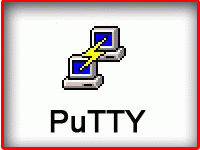 If you've decided to search something useful for your Linux/unix command line skills then this utility program is the right one you should choose. Or you just want to know if someone on his personal computer could log into and/or use other computer over the net? then this small tool has the right answer if you want to do something like that; It's all about logging in to a multi-user computer from another computer, over a network.
If you've decided to search something useful for your Linux/unix command line skills then this utility program is the right one you should choose. Or you just want to know if someone on his personal computer could log into and/or use other computer over the net? then this small tool has the right answer if you want to do something like that; It's all about logging in to a multi-user computer from another computer, over a network.Here, I'm talking about a useful utility for a remote shell client called "PuTTY". And this short article is intended to be a beginner's intro, "first look" for those who know nothing about this useful terminal emulator applicatin. You can visit and get its user manual from Putty FAQ official site if you want to learn completely about this tool as a client for the SSH, Telnet, rlogin, and raw TCP computing protocols.
Putty
- PuTTY was written and is maintained primarily by Simon Tatham (Cambridge, UK.).
- Putty is a cumputer program, software, client, application and as utility.
- Putty is used on Windows Operating System to present Linux/Unix command-line interface.
In really simple terms: you run PuTTY on a Windows machine, and tell it to connect to a Unix machine. PuTTY opens a window. Then, anything you type into that window is sent straight to the Unix machine, and everything the Unix machine sends back is displayed in the window. So you can work on the Unix machine as if you were sitting at its console, while actually sitting somewhere else.
Read Our Basic Unix Commands to get started learning about the basical Unix command-line interface. - PuTTY is a client program for the SSH, Telnet and Rlogin network protocols.
SSH, Telnet and Rlogin are three ways of doing the same thing; logging in to a multi-user computer from another computer, over a network.
Read How to log into Unix Shell in the session using putty if you want to learn about how to get started using the application.
Version History
- Prior to 0.58, three consecutive releases (0.55–0.57) were made to fix significant security holes in previous versions, some allowing client compromise even before the server is authenticated.
- Version 0.58, released in April 2005, contained several new features, including improved Unicode support, for international characters and right-to-left or bidirectional languages.
- Version 0.59, released in January 2007, implemented new features such as connection to serial ports, local proxying, sports SSH and SFTP speed improvements, changes the documentation format (for Vista compatibility) and has several bugfixes.
- The 0.60 version implements three new features and some bugfixes.
Features of Putty
Here I would mention only those features that could represent the main points of the program aim and the intended other purposes on the pass of the history including its bug fixes.Those features are :
- Support for local serial port connections.
- Improved speed of SSH on Windows.
- Storing of hosts in the Default Settings for later use.
- Command-line SCP and SFTP clients, called "pscp" and "psftp" respectively.
- IPv6 support.
- Self-contained executable requires no installation.
- Bug fix: serial connections and local proxies should no longer crash all the time.
- Bug fix: configuring the default connection type to serial should no longer cause the configuration dialog to be skipped on startup.
- Bug fix: "Unable to read from standard input" should now not happen, or if it still does it should produce more detailed diagnostics.
- Bug fix: fixed some malformed SSH-2 packet generation.
Using Putty
To get started using Putty as SSH and telnet program is a relatively simple process.When you start PuTTY, you will see a dialog box. This dialog box allows you to control everything PuTTY can do. You don't usually need to change most of the configuration options. To start the simplest kind of session, all you need to do is to enter a few basic parameters. Please read how to log into Unix in the session using putty to learn how to get started using this program. Just keep in your mind; It's all about using Unix on Windows Operating System. If you are not experienced with the Unix System I think it's good idea to get a little intro to the subject by reading my quick Introduction to Unix and simple guide to The Basical Unix Commands.

0 comments:
Post a Comment